There are thousands of waterfalls in Iceland, but Gullfoss is one of the best. It’s not the tallest or quite the largest by volume, but it is the most popular and rightfully so. If you’re planning a trip to Iceland, Gullfoss waterfall absolutely needs to be on your itinerary. Let’s learn more about this magnificent natural wonder as we help you plan the perfect visit to Gullfoss waterfall.
In This Guide
Here’s what we’re covering in this guide. We invite you to read the full post or jump ahead to the section you’re most interested in.
- Gullfoss Waterfall Facts & History
- How to See Gullfoss Waterfall
- Plan Your Visit to Gullfoss Waterfall
- Get Ready for your trip to Gullfoss
What is Gullfoss Waterfall
Gullfoss is a large waterfall located on the Hvita River in Iceland. The name Gullfoss translates to “Golden Falls,” which is a reference to the golden tint of the water at times. Hvita River is a glacier river, and the high volume of sediment in the water is what creates the golden effect.
What’s interesting about Gullfoss is that the waterfall falls down into a narrow canyon, as opposed to falling from a great height. The landscape around Gullfoss is surprisingly flat, and the waterfall and river cut through it. In fact, you actually have to walk down to get to the top of the waterfall.
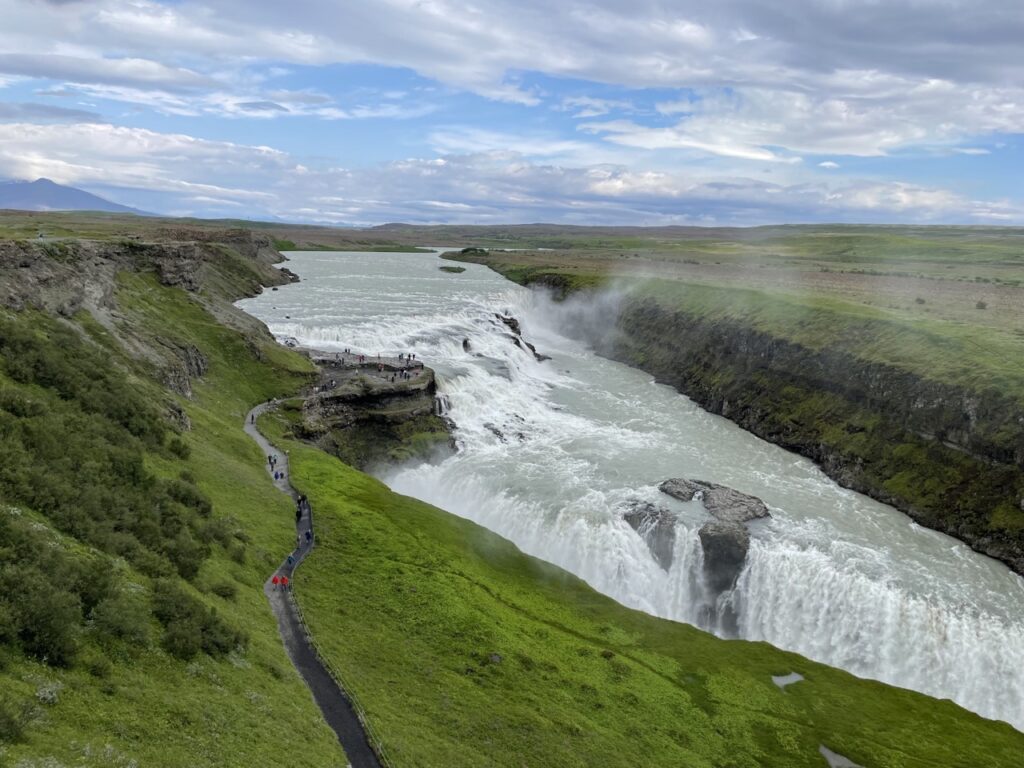
The waterfall is made up of two tiers, totaling 106 feet in height. While this isn’t particularly tall relative to other waterfalls, the width and volume of the waterfall is truly impressive.
Gullfoss averages 575 ft across and dumps an average 4,200 cubic feet of water off its ledge every second (according to World Waterfall Database). This makes Gullfoss is the second largest waterfall by volume in Iceland, second only to Detti Falls.
While the waterfall doesn’t earn many superlatives, the one Gullfoss has earned is most popular. Not all waterfalls in Iceland track visitor information, but this seems to likely be a true claim.
In 2021, Gullfoss attracted 313,399 total visitors. That is an average of 26,117 visitors per month or about 850 visitors a day. The four summer months of June through September accounted for two-thirds (66%) of the total visitors in 2021. (This is all based on numbers provided by Visit Iceland.)
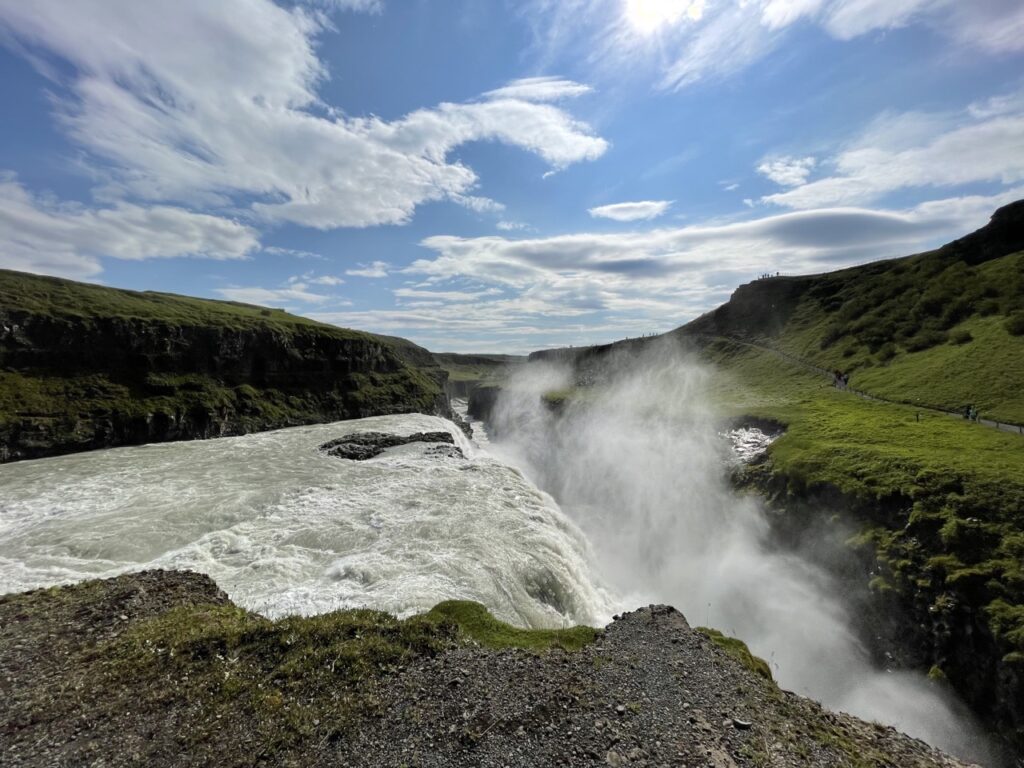
Gullfoss Waterfall Quick Stats
- Height: 106 ft (total for 2 tiers)
- Height Ranking: Not ranked in the top 20 tallest in Iceland
- Volume: 4,200 cfs (cubic feet per second)
- Volume Rank: 2nd in Iceland after Detti Falls
- Average Width: 576 ft
- Water Source: Hvita River
- Annual Visitors: 313,399 in 2021
- Visitor Rank: #1 most popular waterfall in Iceland (probably, given the stats available)
- High Tourism Season: June – September
History of Gullfoss
I wouldn’t usually go into human history relative to natural sites, but this one is interesting so let’s do it!
In the early 1900s, Gullfoss waterfall was located on land that was privately owned by a sheep farmer named Tómas Tómasson.
An English businessman had heard about the powerful waterfall and wanted to build a hydroelectric power plant there. He approachedTómas with hopes of purchasing the land, but Tómas declined. He famously said, “I will not sell my friend.”
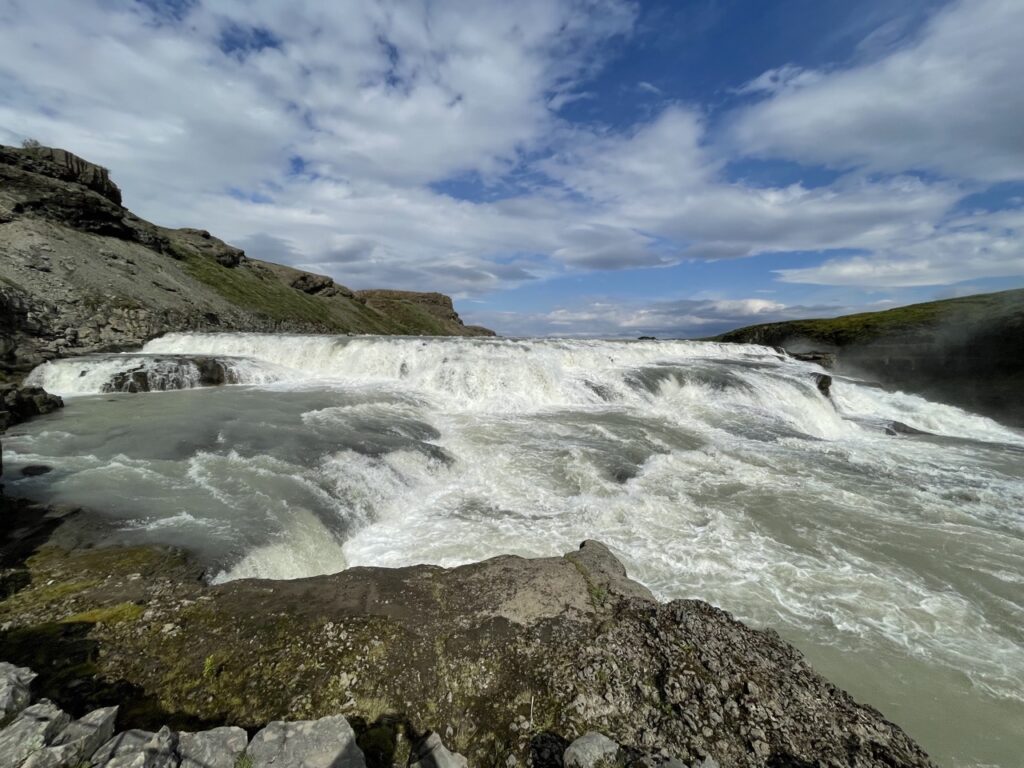
However, he did later agree to lease the land to the businessman. Like any good businessman, the Englishman worked in a loophole that would allow him to move forward with his power plant plan anyway.
Tómas had a daughter, Sigríður, who led the legal battle to protect the waterfall. It was a lengthy and expensive fight, butSigríður was notably relentless in her determination. Ultimately, the businessman could not keep up with the effort and costs required to moved forward with his plan and abandoned it.
Sigríður is hailed as Iceland’s first environmentalist. There is a plaque dedicated to her at Gullfoss and the walkway to the lower observation area is named after her.
In 1979, Gullfoss was designated as a nature reserve, which protects it under Icelandic law.
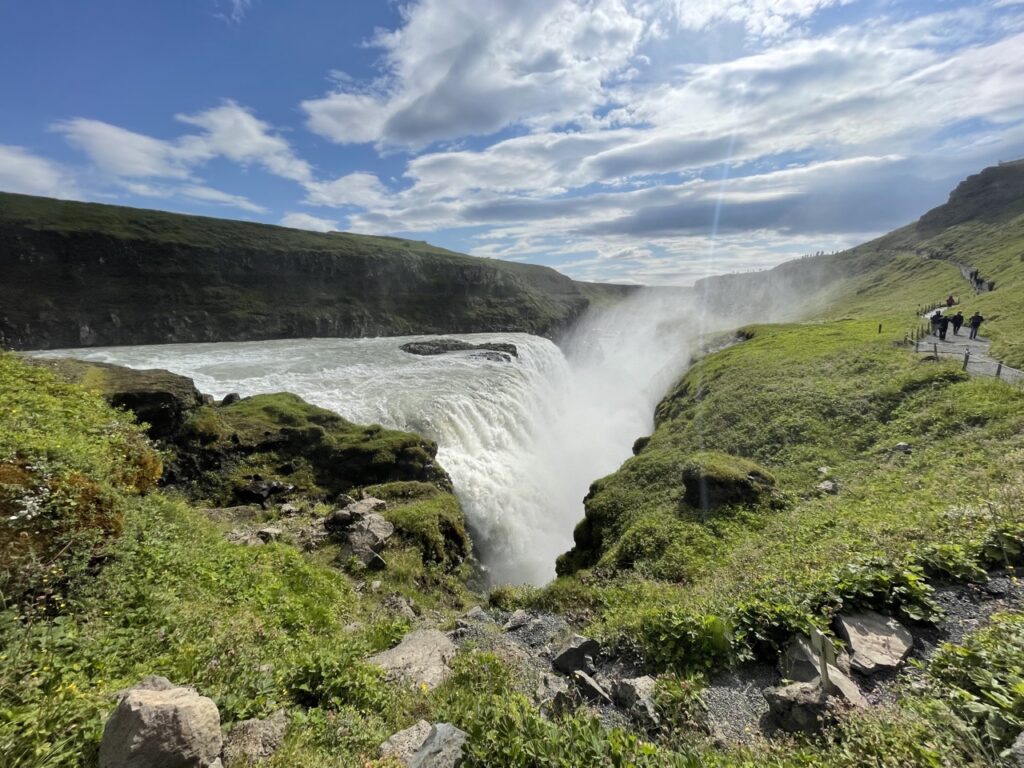
How to See Gullfoss Waterfall
Gullfoss waterfall is one of the most popular waterfalls in Iceland largely because of how easy it is visit. Unlike many waterfalls that require hiking through rugged terrain or driving to far corners of the island, visiting Gullfoss only requires a two-hour drive from Reykjavik and a 5-10 minute walk.
The area on the northwest side of the Hvita River at Gullfoss has been developed to safely allow visitors to see the falls. There are two main viewpoints, upper and lower.
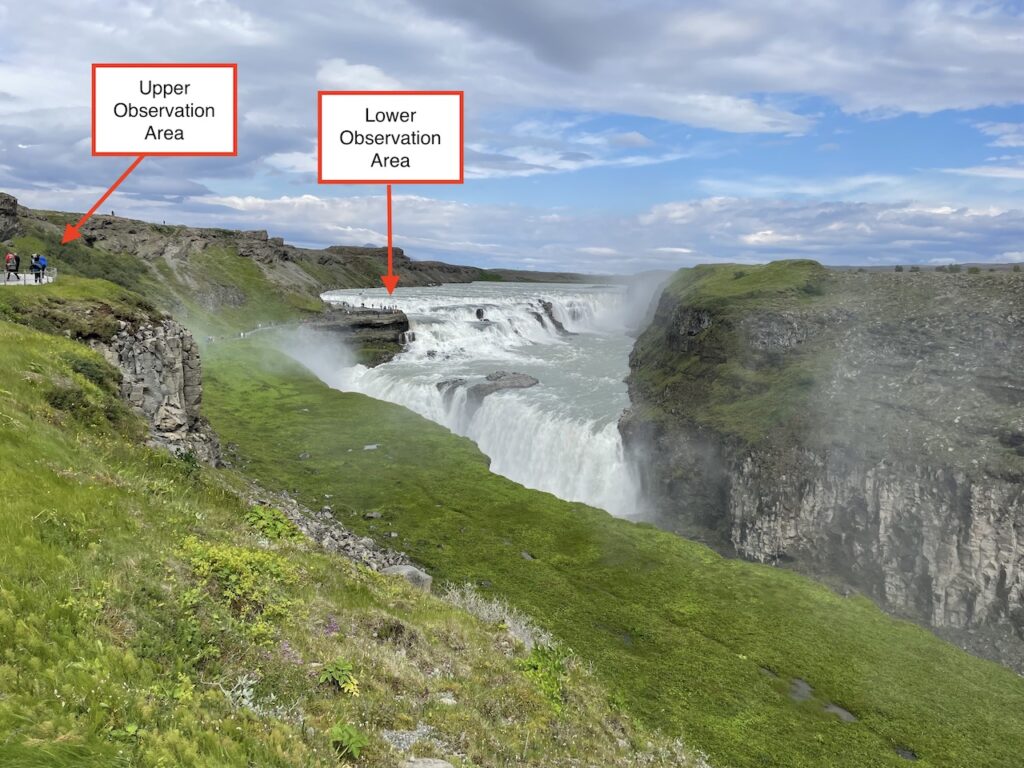
Upper Observation Area
The upper observation area provides a stunning view of Gullfoss from above. This is the best place to see the full landscape around the falls. You can see the upper tier of the falls and watch as the lower tier disappears within the gorge.
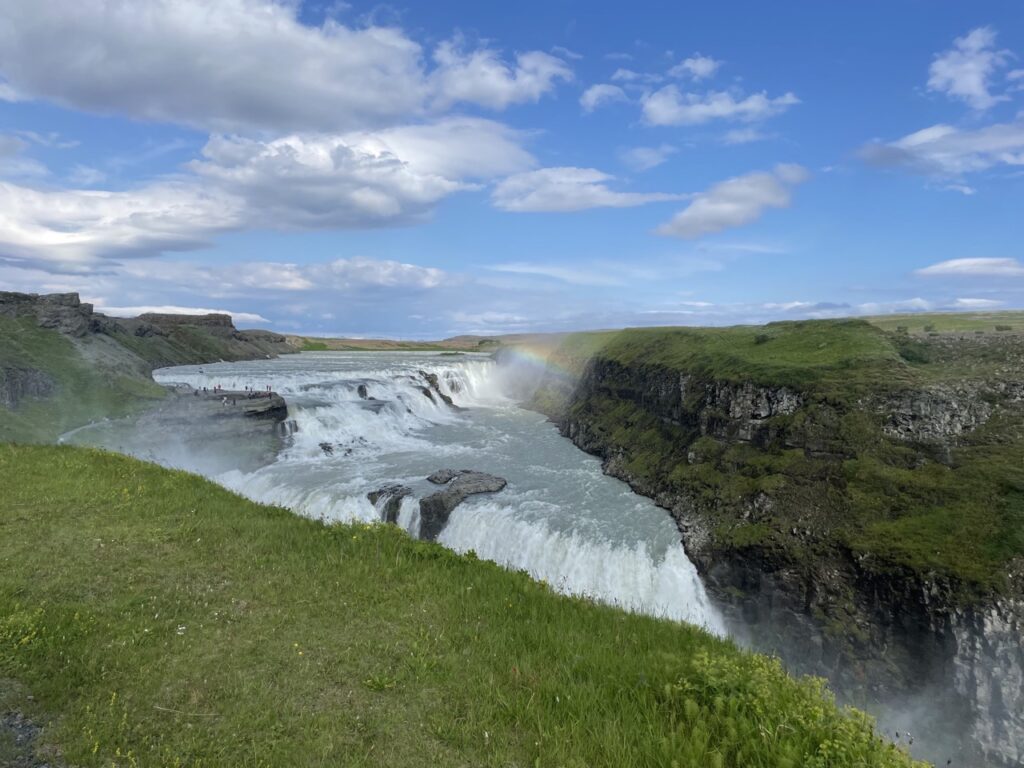
There is a flat, paved path that leads to the upper observation area. It is about 400 meters (1/4 mile) from the main parking lot to the viewpoint. The flat, paved path makes the viewpoint accessible to wheelchairs and strollers, or anyone with mobility issues. In fact, this is the most accessible site I recall visiting in all of Iceland.
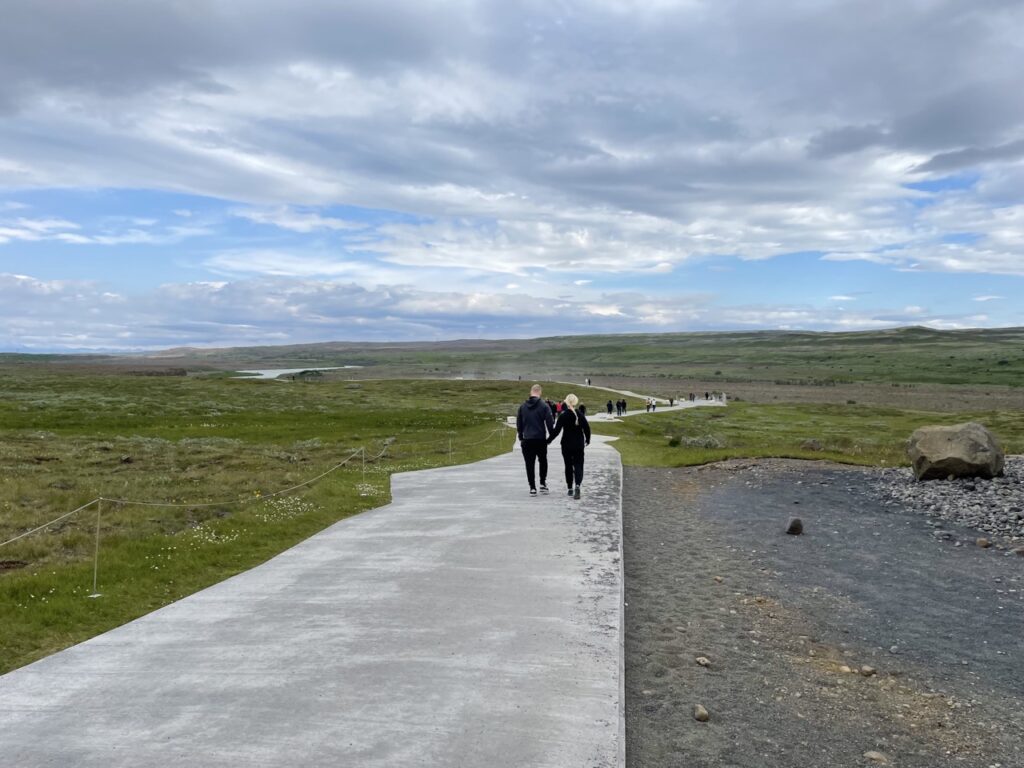
This area can be really windy, though, making it feel quite cold even in the summer. You’ll definitely want to hold on to your hats and pack your favorite windbreaker for this spot.
The upper observation area is open all year.
Lower Observation Area
If the upper observation area provides the best overall view of the landscape, the lower observation provides the best closeup view of the falls themselves. Don’t let the term “lower” confuse you, though. It’s lower relative to the surrounding area, but it’s actually situated right at the top of the falls.
The lower observation area provides an up-close look at the top tier of the falls and a great view of the Hvita river as it cuts through the ravine after the falls.
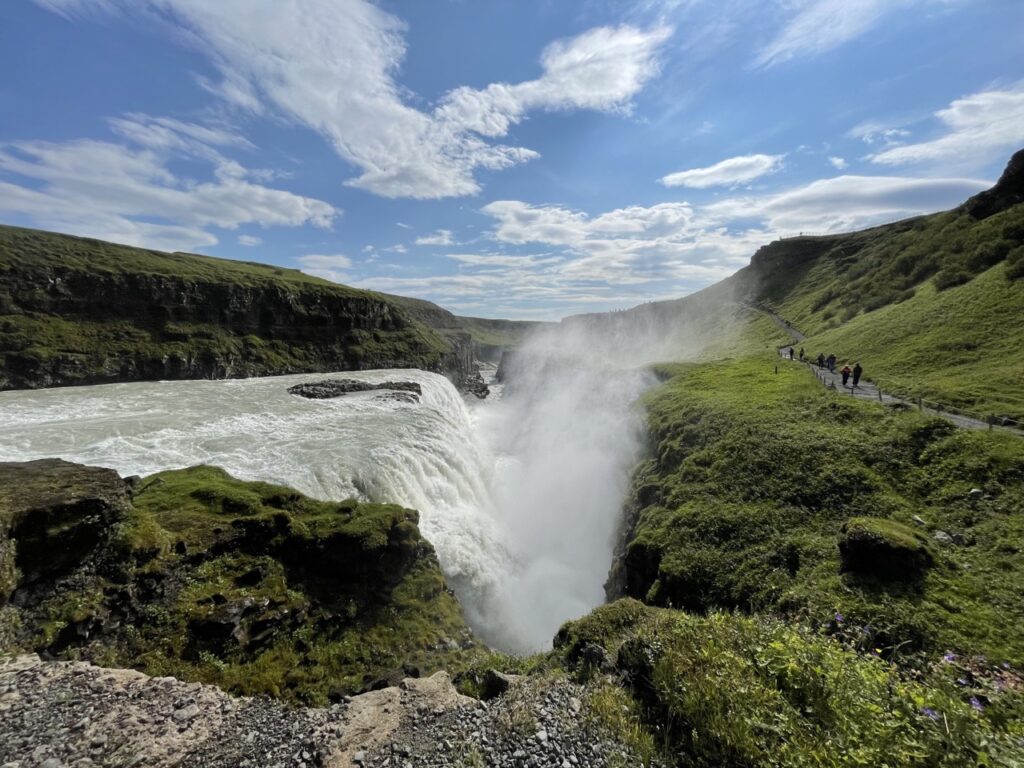
To get to the lower observation area, you’ll need to go down about 100 steps from the visitor center and then walk about 250 meters. (The path is called Sigríður-Pfad, named after the daughter who saved the falls.)
The lower observation area is not any sort of developed platform. It’s actually just the rocks that make up the top of the falls.
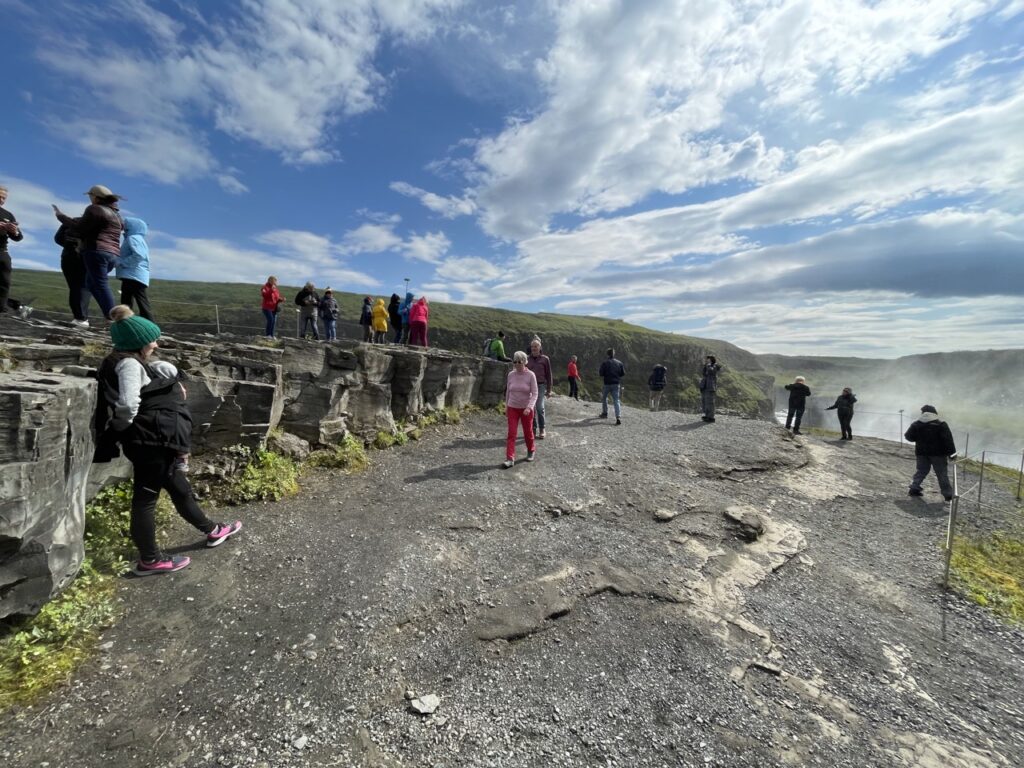
There are two levels, which you can see in the photo above. It takes some finesse to to reach the upper level, so you’ll want to be really careful. You could easily skip this portion though, as the views are not actually better than the flatter section just below it.
The path to the lower observation area is just as stunning as the viewing area itself, if not more so. When the pathway passes the lower tier of the falls, you will catch the most full view of the falls that is visible to pedestrians.
This lower pathway is not as accessible as the one to the upper observation area, but as far as hiking trails go, it would be categorized as easy. The walkway is primarily gravel, with a slight gradient. It is not suitable for strollers or wheelchairs.
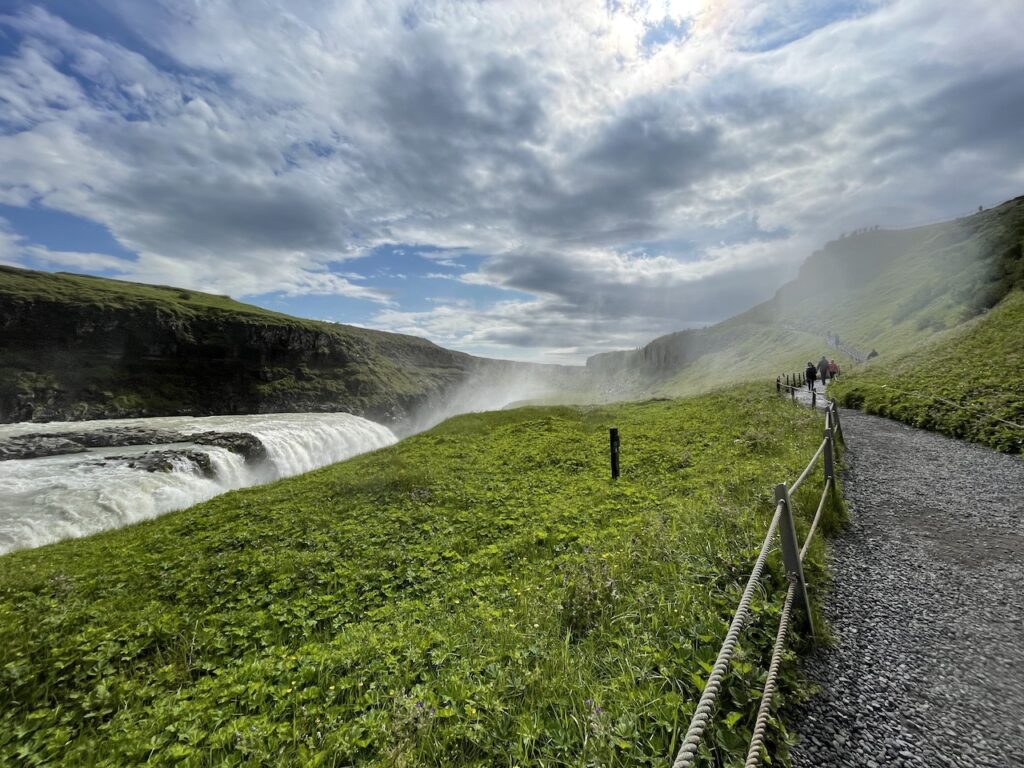
The mist from the falls can get quite intense and it is not uncommon for visitors on the pathway to get wet. We didn’t experience this when visiting in July, but others have. That will likely depend on the wind and water volume when you’re there.
The lower observation area is frequently closed in the winter months due to unsafe conditions. Please respect any closure signs or boundaries. They’re there for your safety.
Plan Your Visit to Gullfoss
Now that we’ve convinced you visit Gullfoss (JK, of course you didn’t need convincing!), let’s start planning. Let’s break down all the logistics so you can plan your perfect visit to Gullfoss.

When to Visit Gullfoss Waterfall
We suggest visiting Gullfoss in the summer. While Gullfoss is open all year, the green grass and crisp blue sky at summertime really accentuated the beauty of the landscape. It was also pretty cold, even in the summer, so it’d be real cold in the winter. We also really loved the lower observation area and that path is not open during the winter.
The summer months between June and September are the most popular time to visit the waterfall. Even though the crowds are higher, it’s a pretty large space and the crowds should not significantly deter from your visit. We visited in July during peak season and had no problems taking photos without other people in them.
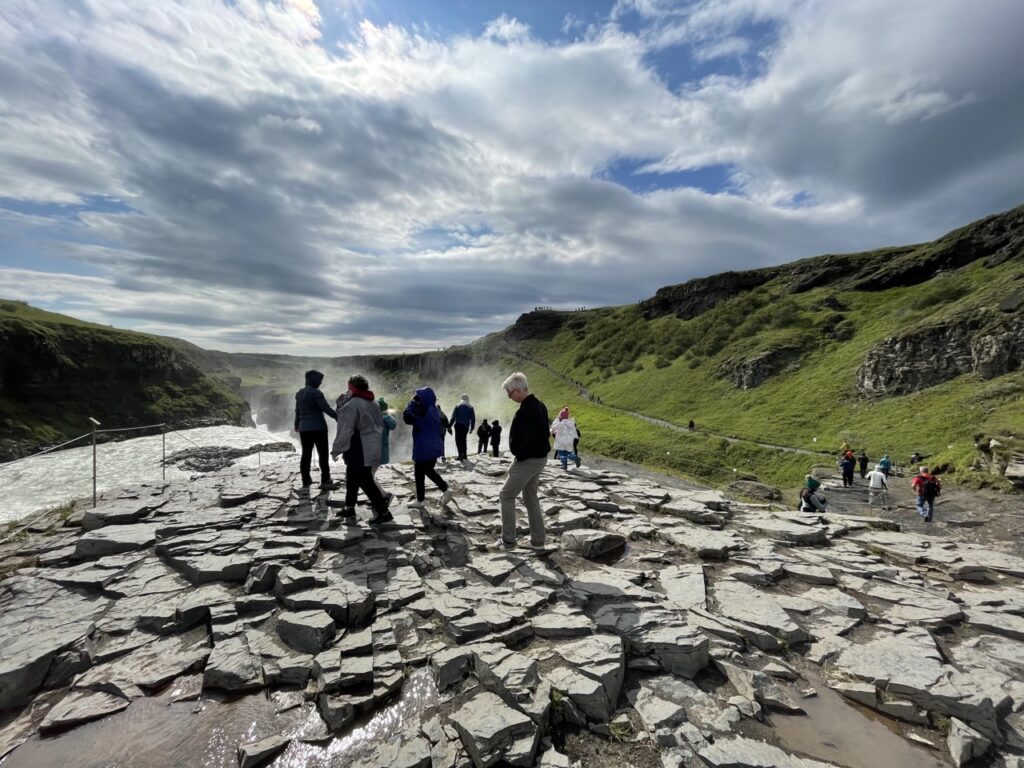
If you are visiting in the winter though, the snow and ice covered falls does look like something out of a storybook. Exercise caution as the walkways can get slippery. And again, the Sigríður-Pfad pathway to the lower observation area is closed in the winter.
The main roads to Gullfoss, the parking lots, and the main upper walkways are plowed during snow. That said, severe winter weather may occasionally result in road closures for safety.
How to Get to Gullfoss Waterfall
Gullfoss is located 72 miles east of Reykjavik. It is easily accessible via car and takes about 1 hour 45 minutes to get there. The route passes Thingvellir and Geysir Hot Spring Area, which most people taking a Golden Circle tour will stop at as well.
Unfortunately you cannot get to Gullfoss by bus or public transit.
If you don’t want to or can’t rent a car to drive to Gullfoss, the other option is to visit with a tour group. Most of these tours will cover the full Golden Circle route and span a variety of activities and durations.
Parking at Gullfoss Waterfall
There are two parking lots at Gullfoss. Most visitors should park at the main parking lot located near the restaurant and gift shop.
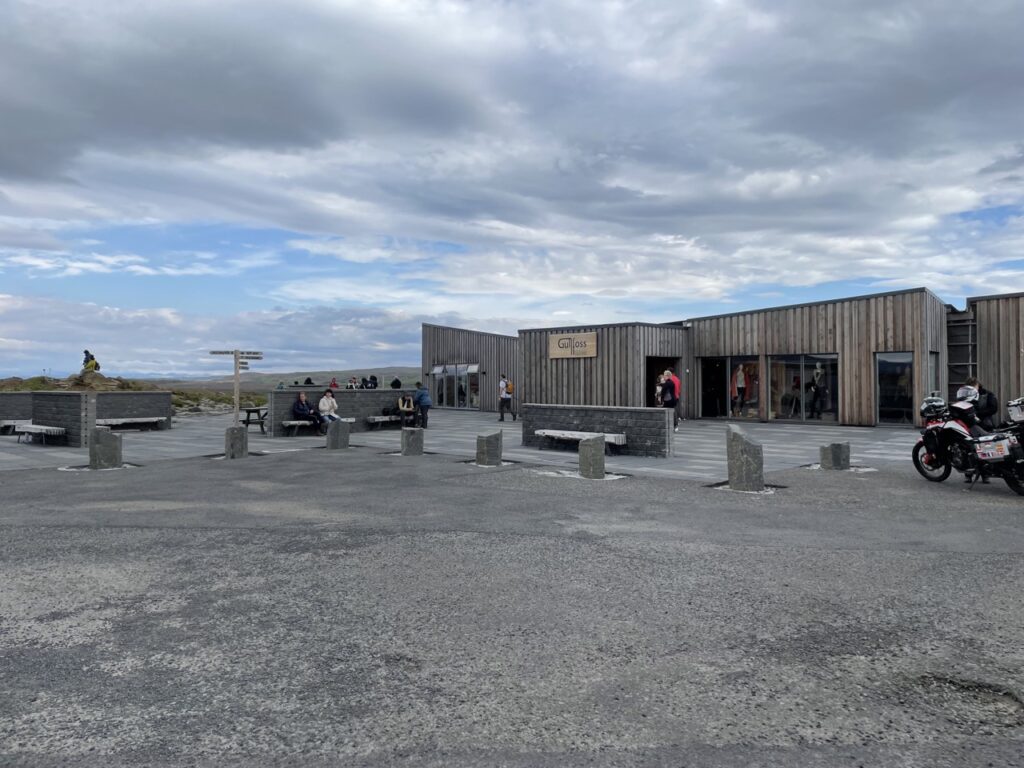
There is a second, lower parking which is located near the bottom of the stairs from the main lot and at the start of Sigríður-Pfad. However, this lower parking lot is only for buses and handicap visitors. There is a sign stating this at the entrance to the road leading to this lot.
If you’re not handicap or a bus, continue past the lower parking lot entrance and you will see the main parking lot. Near the main parking lot, you’ll find bathrooms, the cafe, the start of the walkway to the upper viewing area and the stairs down to the walkway to the lower viewing area.
How Much Time to Spend at Gullfoss Waterfall
Plan to spend 1 to 2 hours at Gullfoss waterfall.
One hour is enough time to walk to the upper observation area and take a few photos, and then walk to the lower observation area and have time to soak it in (hopefully not literally).
Photographers trying to get really good photos or waterfall enthusiasts who just really like waterfalls, may end up spending another 30 minutes – 1 hour there. Anyone who wants to warm up with a bowl of lamb stew (we’re vegetarian, so that’s a pass for us, but rumor has it it’s great) or do some shopping should also plan for an extra 30 minutes.
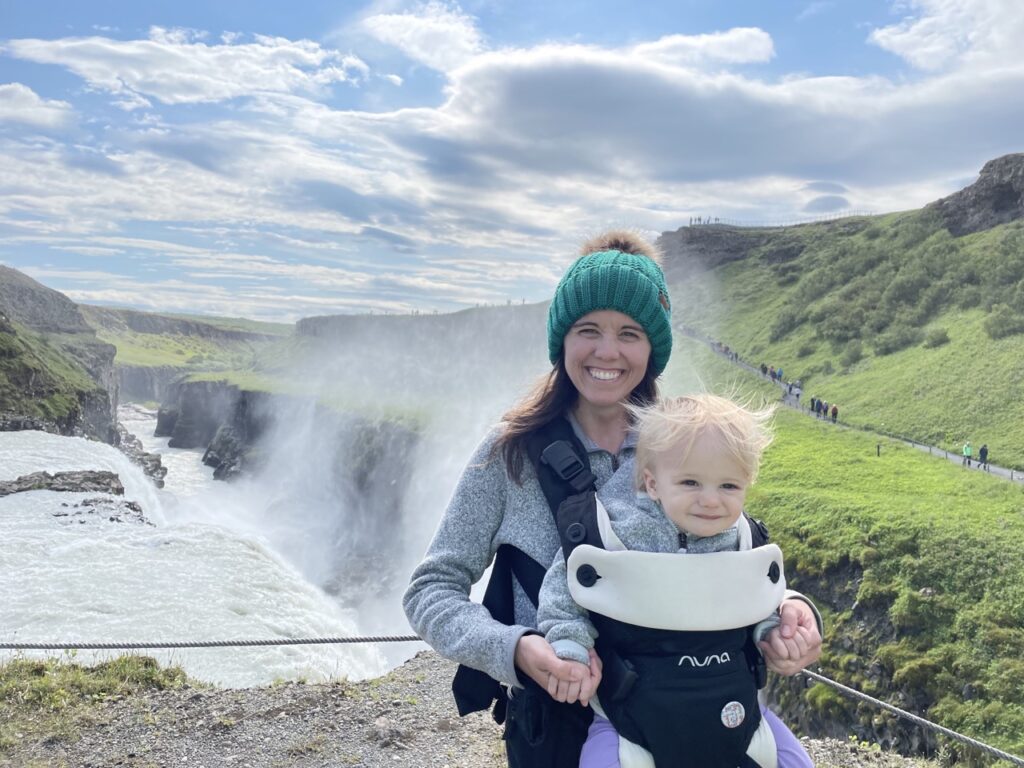
How Much Does it Cost to Visit Gullfoss Waterfall?
It is free to visit Gullfoss waterfall. Parking at Gullfoss is also free.
The only additional costs at Gullfoss are for the optional purchase of food, drinks or souvenirs.
Amenities at Gullfoss Waterfall
There is a cafe and gift shop located by the main parking lot. The following services are available at this location.
- Wifi: Yes, free wifi is available at the cafe.
- Bathrooms: Yes. There is a small, separate bathroom building near the cafe which costs a small fee to use. There are also bathrooms inside the cafe which are free to use when the cafe is open.
- Souvenirs: Yes, there’s a variety of trinkets and clothing available for purchase.
- Parking: Yes, free parking
- Coffee: Yes, there is a coffee shop inside that serves coffee and espresso beverages.
- Food: Yes, a limited variety of sandwiches, stew, and snacks are available. Of the three stops on the Golden Circle, this is the most limited selection.
- Dining Space: The tables for dining are located indoors. There are benches available outside as well. (Noting this due to the pandemic for people who may only want to dine outdoors.)
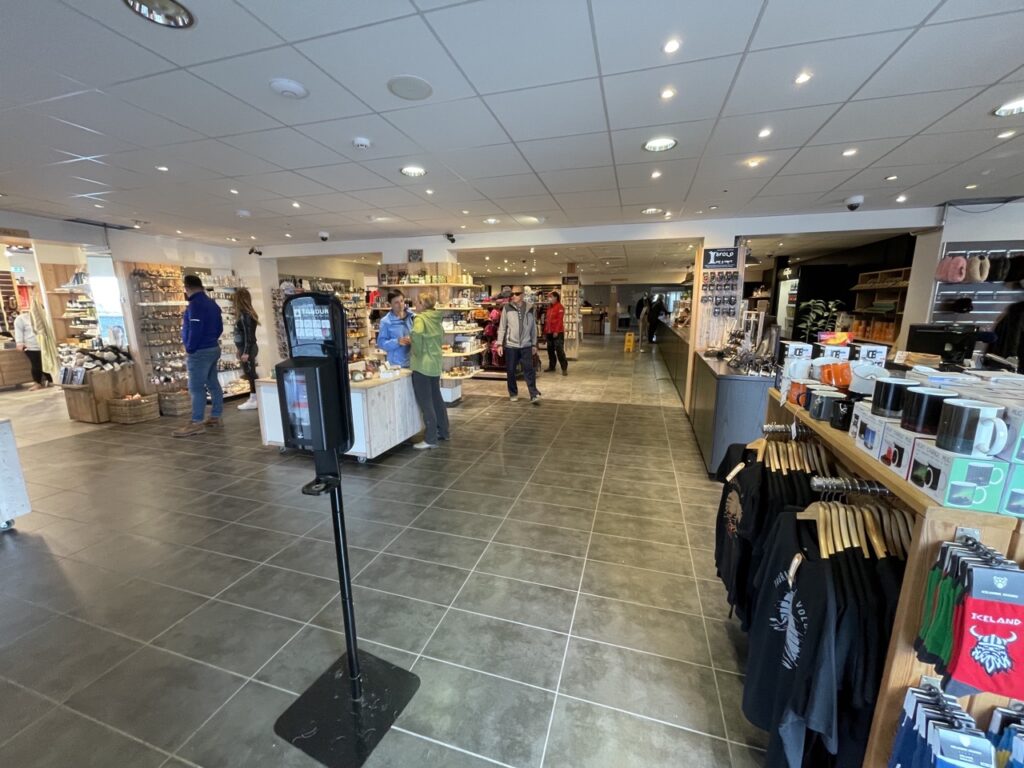
Where to Stay
For most visitors, we recommend staying in Reykjavik. Gullfoss is an easy day trip from there, especially when combined with Thingvellir and Geysir Hot Spring Area for the Golden Circle tour.
As the country’s largest city, Reykjavik is where you’ll have the best selection and prices for places to stay. We stayed at Kex Hostel, a family-friendly hostel along the shore walk. We loved it and highly recommend it for all travelers, not just families.

For some visitors though, the Golden Circle may just be the beginning to a longer journey. These travelers may be driving the full Ring Road or exploring the southern coast (glacier lagoon anyone?). For those people, it doesn’t make sense to go back to Reykjavik.
For that group of travelers, we recommend staying in the town of Fludir. It’s a small town about 30 minutes from Gullfoss. There are a handful of guesthouses to choose from, several restaurants and a grocery store. We stayed at Guesthouse Fludir and it was lovely.
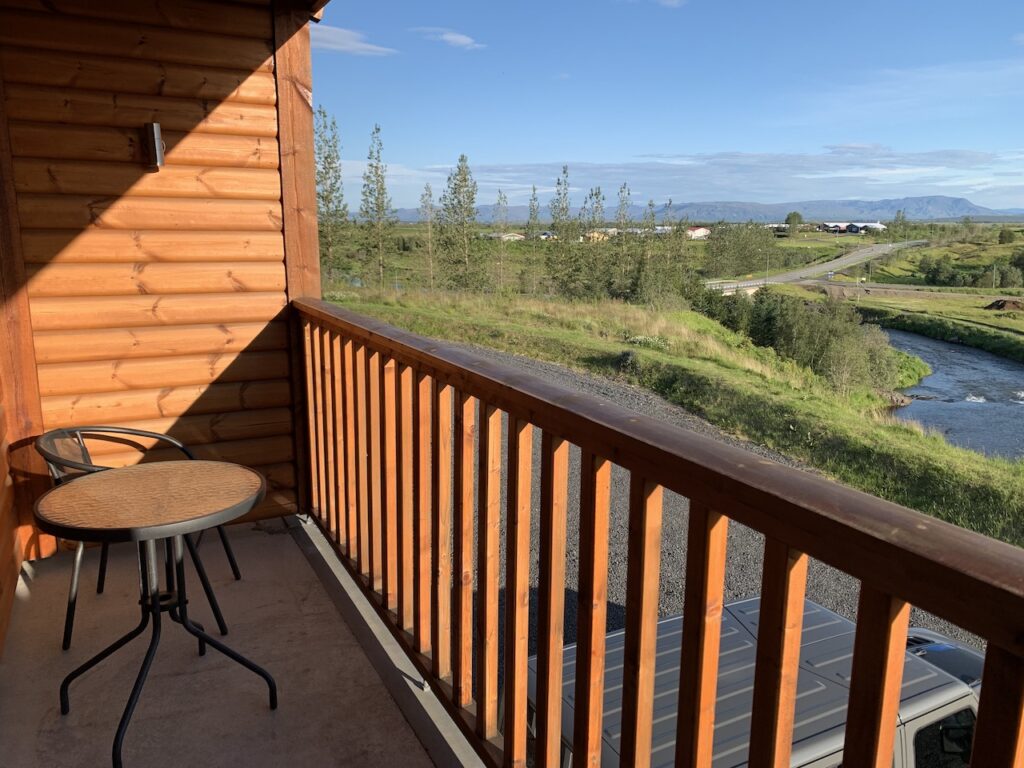
Get Ready for your Visit to Gullfoss Waterfall
Now that your trip is planned, it’s time to get ready. Here’s a few things to get in mind as you prepare for your visit to Gullfoss.
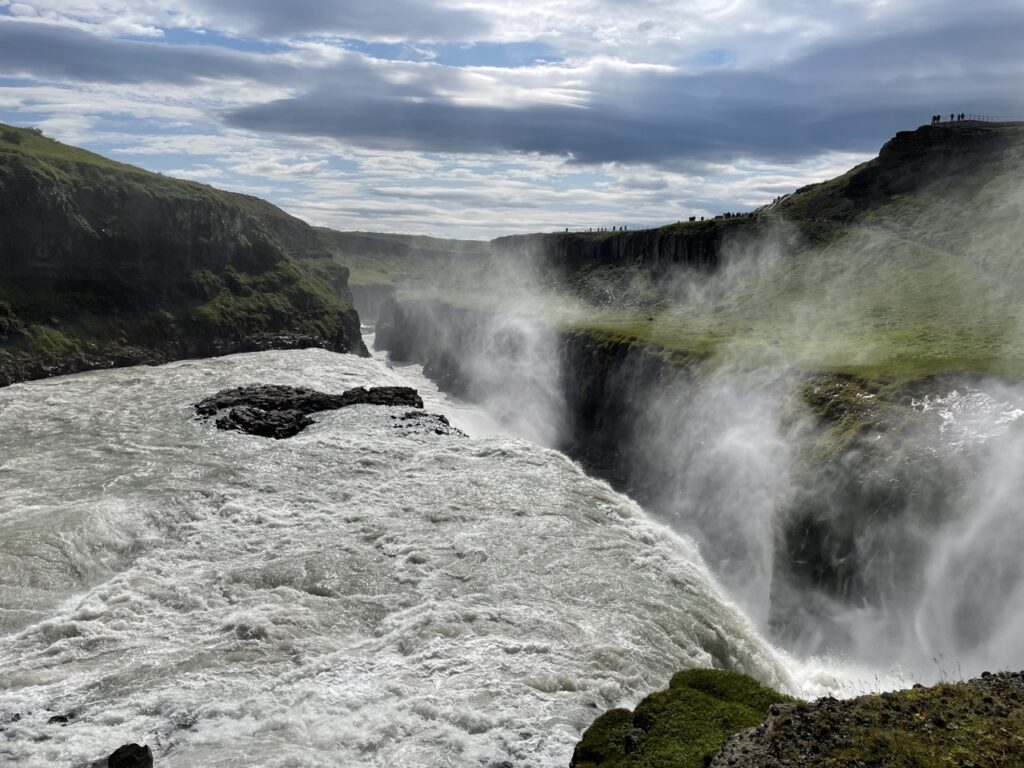
Tips for Visiting Gullfoss
- Wipe off your camera lens often. It can be very misty at the lower observation area, which can splash on or fog up your camera lens. The last thing you want is all your photos to be blury! I do this frequently in all situations, but’s extra important with all of the moisture at Gullfoss.
- Stop frequently along Sigríður-Pfad. Most people are walking the pathway as a way to get to the observation area near the top of the falls, but some of the best views of the falls are from the path itself! Take breaks along the way to observe the falls from the different angles. (Be sure to actually stop though – don’t let the views distract you from walking safely!)
- Visit both observation areas. If you’re able, don’t pass up the chance to visit both the upper and lower observation areas. They both give such great and different views.
What to Wear to Gullfoss
- Windproof & waterproof jacket: The upper observation area can be really windy, and the walk to the lower observation area can be really wet (not only during the rain). One jacket that is both windproof and waterproof is the way to go. I live and die by my North Face Apex Bionic jacket, but when mine wears out I will definitely buy the hooded version.
- Wicking base layer: Waterproof jackets cant get really steamy on the inside, so I like to have a sweat wicking layer closest to my skin.
- Cozy Fleece: This depends on the season, but we were there in July and I was happy to have it. I call my Patagonia Better Sweater + North Face Apex Bionic shell my “cozy combo.” I like that the fleece is cozy and the shell protects from the elements. I had to shed my outer layer to wrap up my sleeping toddler, so I was extra happy to have a fleece.
- Sturdy Shoes: Hiking shoes or boots aren’t completely necessary for Gullfoss, but you’ll want something with decent traction if you’ll be walking the pathway to the lower observation area.
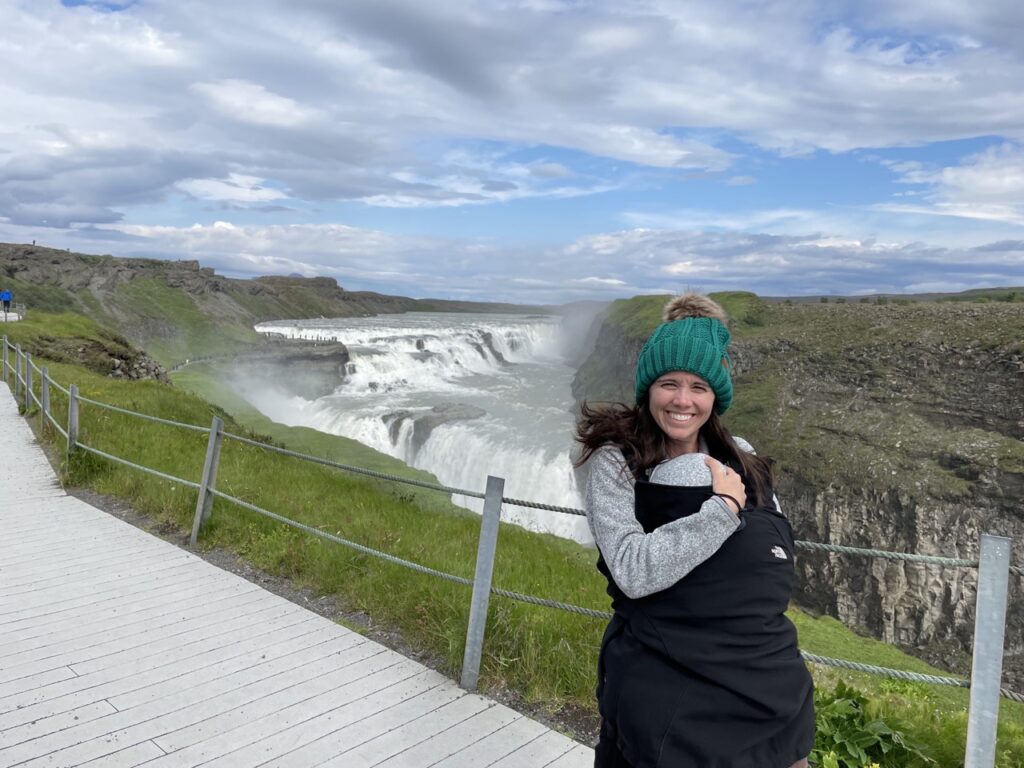
What to Bring to Gullfoss
Since you don’t have to venture too far to view Gullfoss, there’s actually not too much that you need to bring with you. We did think of a few things, though!Also be sure to check our minimalist Iceland packing list to help get ready for your whole trip.
- Waterproof Backpack Cover: Even if the weather doesn’t call for rain, you may get wet on the pathway to the lower observation area. We loved having a waterproof backpack cover with us so we never had to worry about our stuff getting wet.
- Warm Beanie: As you can see from my husband’s killer look, it was too windy to wear a baseball hat without worrying about it flying away. Keep your head covered with a cozy knit hat instead. I picked up this hat up a few days before our trip and wore it almost every day.
- Baby Carrier: Parents of small children will want to pack a baby carrier. The path to the lower observation area is not safe for strollers. It’s also narrow and has a horrifying drop so we did not feel comfortable letting our toddler walk around on the lower path or observation area. We used the Nuna CUDL carrier. We have a separate post dedicated to baby wearing for travel, which includes are best tips and reviews of our favorite baby carriers.
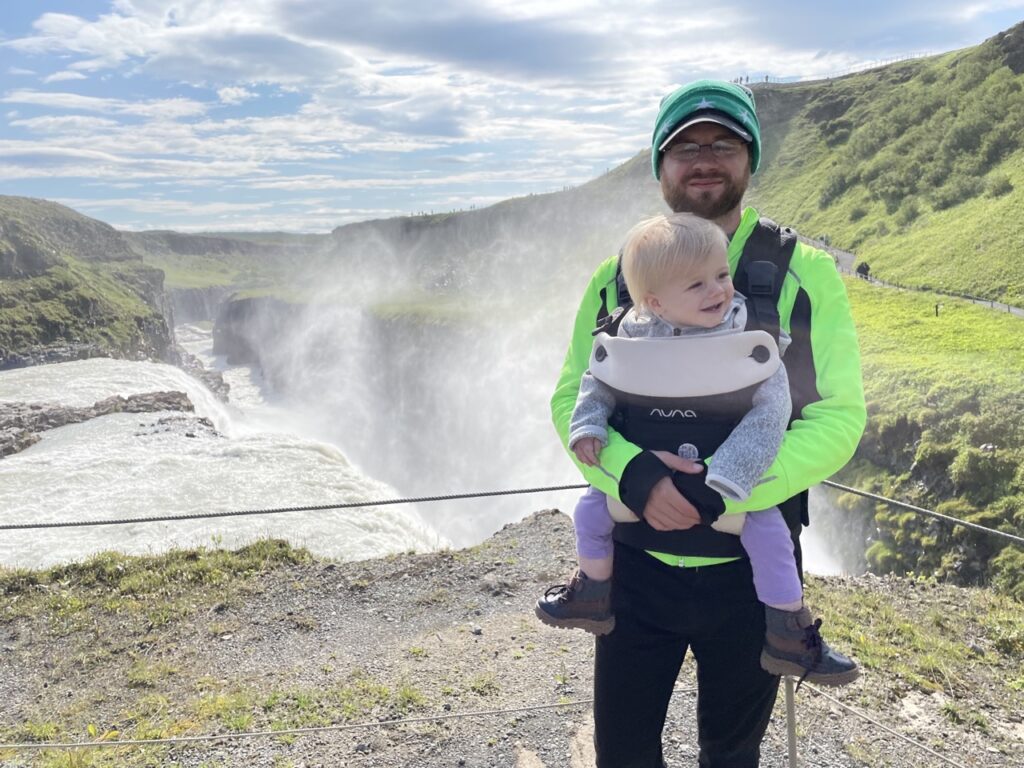
Conclusions
Gullfoss waterfall is truly stunning. I will never forget its power and beauty. If you have the chance to visit Iceland, don’t pass up the opportunity to see this gem in person.
We hope you found this guide helpful! If there’s anything we’re missing, please let us know in the comments.
Whether you’re in Iceland now or planning your dream trip, we hope you have an amazing adventure.

Our Full Iceland Itinerary
Planning a trip to Iceland? Here’s a look at our full itinerary for this trip…
- Minimalist Iceland Summer Packing List (That Fits in One Carry-On!)
- Detailed 3-Day Reykjavik Itinerary with Walking Routes
- Reykjavik City Guide – Everything to Know About Iceland’s Capital City
- Whale Watching in Reykjavík with Special Tours
- Planning Guide: Self-Drive the Golden Circle in Iceland
- Guide to Thingvellir National Park in Iceland
- Guide to Gullfoss Waterfall in Iceland
- Guide to Iceland’s Geysir Hot Spring Area
- A Perfect Visit to Seljalandsfoss Waterfall + Bonus Hidden Waterfall
- Planning Guide: Skogafoss Waterfall in Iceland
- Guide to Dyrhólaey Nature Reserve on Iceland’s Southern Coast
- Complete Guide to Vik, Iceland
- Guide to Reynisfjara Black Sand Beach in Iceland
- Guide to Jökulsárlón, Iceland’s Glacier Lagoon
